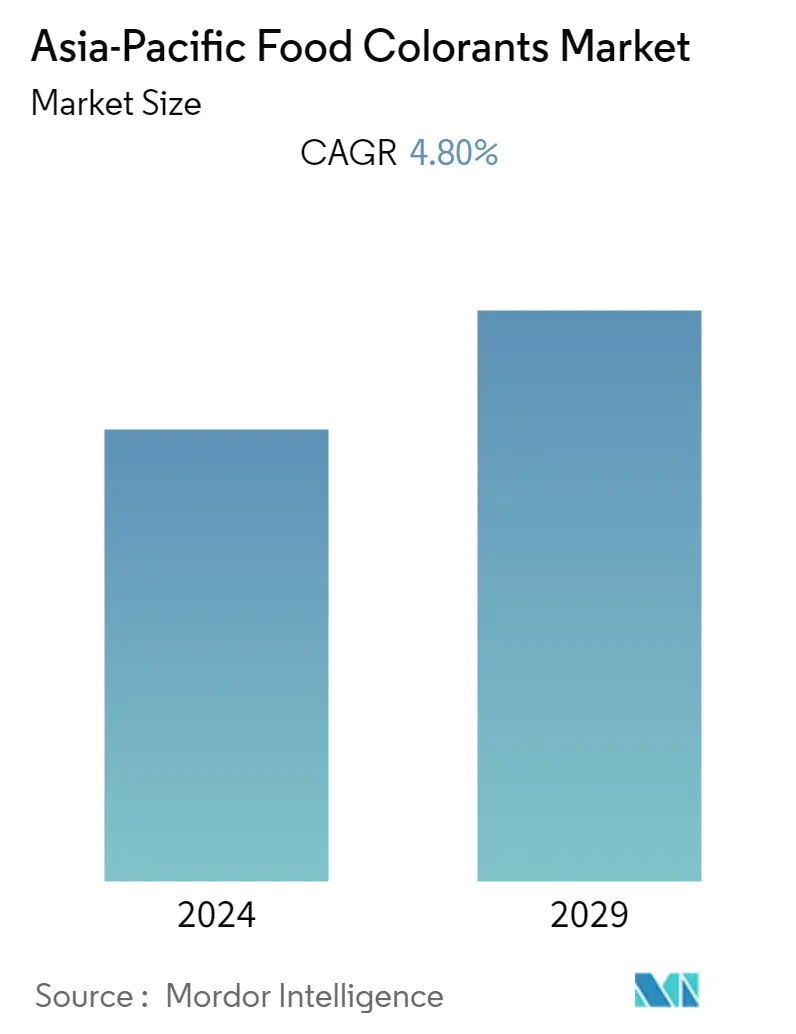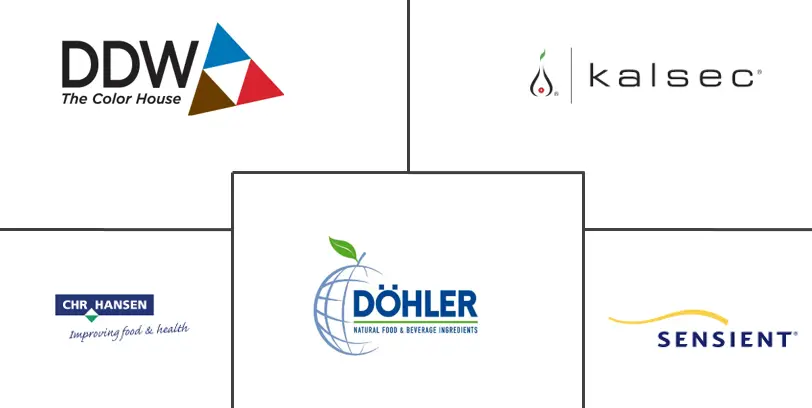Market Size of Asia-Pacific Food Colorants Industry

| Study Period | 2019 - 2029 |
| Base Year For Estimation | 2023 |
| Forecast Data Period | 2024 - 2029 |
| Historical Data Period | 2019 - 2022 |
| CAGR | 4.80 % |
| Market Concentration | Low |
Major Players
*Disclaimer: Major Players sorted in no particular order |
APAC Food Colorants Market Analysis
The Asia-Pacific food colorant market is projected to witness at a CAGR of 4.8% during the forecast period.
- The demand for natural colors varies across the region, with a higher penetration level in Australia and Japan. At the same time, there is significant potential for conversion from synthetic colors in China and Southeast Asia.
- The driving factor for natural food colorants is the prevalence of food safety scandals and the recycling of waste oil. For instance, animal feed oils were synthetically colored and sold as healthier vegetable oils in Taiwan, toxic toothpaste was produced in China and imported around the world, and high levels of lead were found in packet noodles in India.
- The different regulatory environments in the countries are affecting the food colorants market, due to the rise in food safety issues.
APAC Food Colorants Industry Segmentation
The Asia-Pacific food colorant market includes natural color, synthetic color, and coloring foodstuff. The health-enhancing properties of natural colors, combined with the organic properties of natural products, are increasing the demand for natural colors. The market is segmented by application into beverages, dairy products, bakery products, confectionery, savory snacks, and other applications.
| By Product Type | |
| Natural Color | |
| Synthetic Color |
| By Application | |
| Beverages | |
| Dairy Products | |
| Bakery Products | |
| Savory Snacks | |
| Confectionery | |
| Other Applications |
| By Country | |
| China | |
| Japan | |
| India | |
| Australia | |
| Rest of Asia-Pacific |
Asia-Pacific Food Colorants Market Size Summary
The Asia-Pacific food colorants market is experiencing a notable growth trajectory, driven by a shift towards natural colorants due to increasing consumer awareness and concerns over food safety. The demand for natural colorants is particularly strong in Australia and Japan, while there is significant potential for transitioning from synthetic to natural colorants in China and Southeast Asia. This shift is largely influenced by food safety scandals and regulatory challenges in the region, which have heightened consumer demand for clean label products. Consumers are increasingly interested in understanding the ingredients in their food, prompting a preference for natural over synthetic colorants. The market is further bolstered by the stringent regulations in countries like Japan, which restrict the use of synthetic colorants, thereby creating opportunities for natural colorant manufacturers.
The Asia-Pacific food colorants market is characterized by its diverse applications across various food segments, including dairy, confectionery, meat, beverages, and bakery, with moderate use in oils and fats. The market is dominated by key players such as Chr Hansen, DD Williamson, DSM, Doehler Group, and Kalsec, who are actively expanding their presence through strategic mergers and acquisitions. These companies are focusing on geographical expansion and new product development to strengthen their market position. The growing trend of incorporating natural ingredients in food products is a significant factor contributing to the market's expansion, with Japan's culinary practices further driving the demand for specific colorants.
Asia-Pacific Food Colorants Market Size - Table of Contents
-
1. MARKET DYNAMICS
-
1.1 Market Drivers
-
1.2 Market Restraints
-
1.3 Porter's Five Forces Analysis
-
1.3.1 Threat of New Entrants
-
1.3.2 Bargaining Power of Buyers/Consumers
-
1.3.3 Bargaining Power of Suppliers
-
1.3.4 Threat of Substitute Products
-
1.3.5 Intensity of Competitive Rivalry
-
-
-
2. MARKET SEGMENTATION
-
2.1 By Product Type
-
2.1.1 Natural Color
-
2.1.2 Synthetic Color
-
-
2.2 By Application
-
2.2.1 Beverages
-
2.2.2 Dairy Products
-
2.2.3 Bakery Products
-
2.2.4 Savory Snacks
-
2.2.5 Confectionery
-
2.2.6 Other Applications
-
-
2.3 By Country
-
2.3.1 China
-
2.3.2 Japan
-
2.3.3 India
-
2.3.4 Australia
-
2.3.5 Rest of Asia-Pacific
-
-
Asia-Pacific Food Colorants Market Size FAQs
What is the current Asia-Pacific Food Colorants Market size?
The Asia-Pacific Food Colorants Market is projected to register a CAGR of 4.80% during the forecast period (2024-2029)
Who are the key players in Asia-Pacific Food Colorants Market?
Chr. Hansen Holding A / S, D.D. Williamson, Sensient Technologies Corporation, Döhler and Kalsec Inc are the major companies operating in the Asia-Pacific Food Colorants Market.

